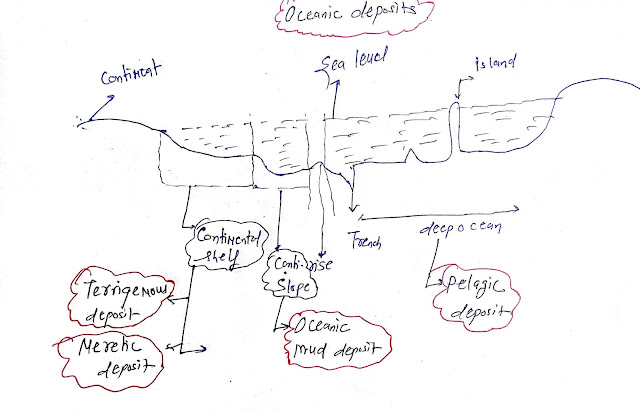Give a brief account of ocean deposits.
( UPPSC / UPPCS, 2019, 15 Marks)
महासागर निक्षेप का संक्षिप्त विवरण दीजिये।
Keywords:
Mud, red mud, blue mud, green mud,
ooze,
neritic,
pelagic,
Terrigenous,
Calcareous
Siliceous
ooze,
neritic,
pelagic,
Terrigenous,
Calcareous
Siliceous
Answer:
All the abiotic and biotic deposits on all the relief features of the ocean floor such as a continental shelf, continental rise, and abyssal plains; are called oceanic deposits.
Oceanic deposits are around 500-meter depth, we get information about the history of climate over the earth by studying ocean deposits.
Sources of oceanic deposits:
- Natural source
- Human source
Natural sources of Oceanic deposits:
The following are:
- River deposits: most of the river deposits are settled on the continental shelf.
- Wave deposits through Marine erosion.
- Winds deposits from the desert region
- Volcanic deposits: both from the lithosphere and ocean volcanic origin deposit sand, volcanic dust gets settled into the ocean.
- Normal Atmospheric clouds of dust sink through precipitation
- Carbon sinking
- Dead Phyto and zooplankton deposits
- Glaciers deposits in higher latitude
- Meteorites deposits.
Human sources of oceanic deposits:
The following are:
- Industrial waste
- Urban waste
- Agriculture waste
- Space debris
- Agricultural waste
- Tourist garbage
Types of oceanic deposits:
There are two types of Oceanic deposits:- Oceanic Mud
- Ooze deposits
Oceanic Mud:
These are four types:- Red mud
- Blue mud
- Green mud
All mud are terrigenous deposits.
Red mud:- Red color due to the presence of ferric iron. It is found on the continental slope.
Blue mud:
- Found in continental slope.
- Fine plastic terrigenous deposits
- Blue Colour due to the presence of iron sulfide.
Green mud:
- Green mud due to the presence of calcium carbonate.
Ooze oceanic deposits:
It is oceanic deposits comprise at least 30 % of the organism's skeleton. Ooze deposits are found in the continental rise and abyssal plains.
The following are types of Ooze deposits:
- Inorganic or non-biogenic material:
- Terrigenous
- Red clay
- Organic or biogenic material:
- Neritic in shallow depth
- Pelagic in the deep ocean; it is hard to part of biotic.:
- Calcareous
- Siliceous
- Gravel, sand, silt, clay carried by river, winds, and waves.
Calcareous ooze:
- It is an organic ocean deposit, it is a dead organism shell that is made of calcium carbonate.
- Region:
- The Indian ocean and the Atlantic ocean.
Siliceous ooze:
- It is an organic deposit, made up of an organic shell of silica.
Distribution of oceanic deposits:
The following diagram explains the distribution of oceanic deposits.
 |
| Distribution of ocean deposit |
You may like also:
ConversionConversion EmoticonEmoticon